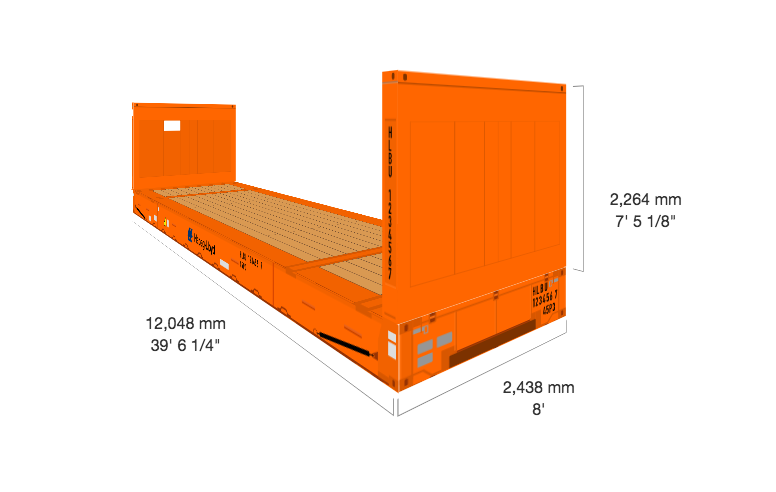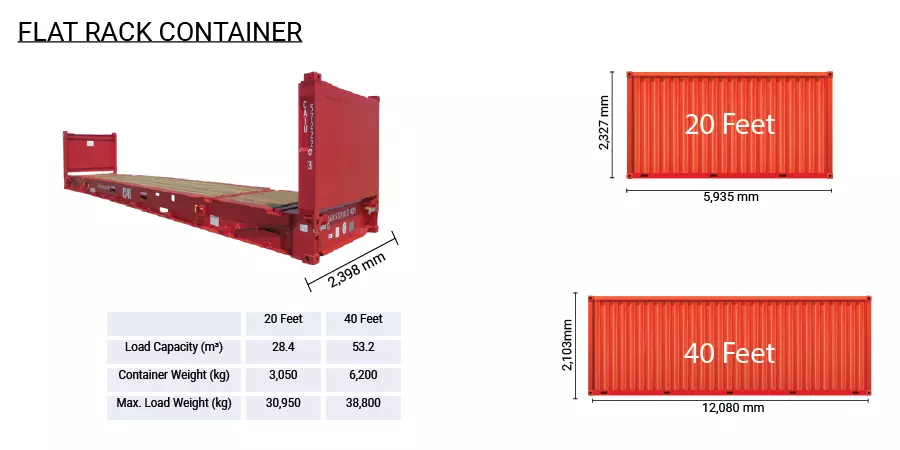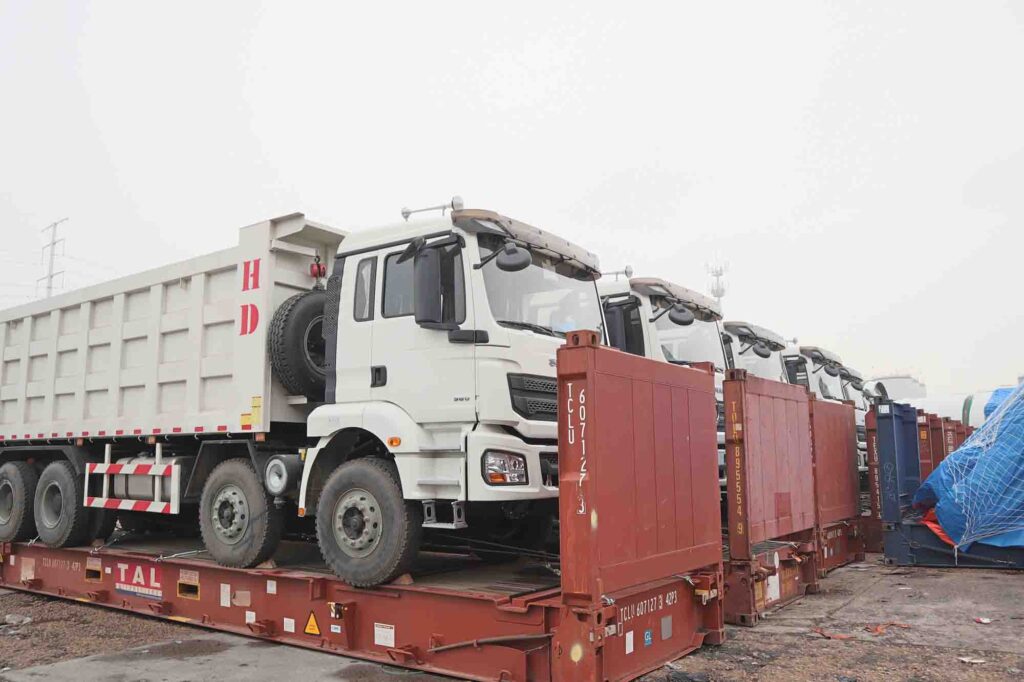Flat rack containers are a specialized type of intermodal freight container designed to transport oversized or heavy cargo that cannot fit into standard containers. These containers have a unique structure with collapsible or fixed end walls but lack side walls, allowing them to accommodate wide, tall, or awkwardly shaped items.
In this detailed guide, we will discuss the flat rack container specifications, their uses, dimensions, and benefits. By understanding these specifications, you can make informed decisions when selecting a flat rack container for your shipping needs.
What Is a Flat Rack Container?
A flat rack container is a shipping container designed specifically for transporting cargo that is too large for standard shipping containers. It consists of a flatbed platform with either fixed or collapsible ends, but no side walls or roof. This open structure makes it easy to load and unload bulky, irregularly shaped cargo such as machinery, vehicles, pipes, and construction materials.
Flat rack containers come in different sizes, typically in 20-foot and 40-foot variants, and are made from durable steel, ensuring they can handle heavy loads during transport. They are primarily used in industries such as construction, manufacturing, and logistics, where oversized cargo is a regular occurrence.
Types of Flat Rack Containers
There are two main types of flat rack containers:
- Collapsible Flat Rack Containers
Collapsible flat rack containers feature end walls that can be folded down when not in use. This makes them highly flexible and easier to store or stack when not loaded with cargo. They are ideal for shipping goods that require extra handling space. - Fixed End Flat Rack Containers
Fixed-end flat rack containers have solid, non-collapsible end walls that provide extra structural support. This type is best suited for transporting very heavy items that require stable end walls for secure loading and unloading.
Flat Rack Container Dimensions
The specifications for flat rack containers can vary depending on the manufacturer or the intended application. However, standard dimensions for the most common types (20-foot and 40-foot containers) are as follows:
20-Foot Flat Rack Container Dimensions:
- External Length: 6.06 meters (20 feet)
- External Width: 2.44 meters (8 feet)
- External Height: 2.59 meters (8.5 feet)
- Internal Length: 5.94 meters
- Internal Width: 2.35 meters
- Internal Height: 2.15 meters
- Tare Weight: 2,360 kilograms
- Maximum Payload: 31,620 kilograms
- Maximum Gross Weight: 34,000 kilograms

40-Foot Flat Rack Container Dimensions:
- External Length: 12.19 meters (40 feet)
- External Width: 2.44 meters (8 feet)
- External Height: 2.59 meters (8.5 feet)
- Internal Length: 11.76 meters
- Internal Width: 2.35 meters
- Internal Height: 1.96 meters
- Tare Weight: 5,200 kilograms
- Maximum Payload: 39,800 kilograms
- Maximum Gross Weight: 45,000 kilograms
Flat Rack Container Specifications Explained
Understanding the specific components of flat rack containers is key when selecting the right one for your cargo. Let’s break down some important aspects of these specifications:
- External and Internal Dimensions
The external dimensions refer to the overall size of the container, while the internal dimensions represent the usable cargo space. Keep in mind that while the external dimensions of a flat rack are standardized, the internal dimensions can vary slightly depending on the design and manufacturer. - Tare Weight
This is the weight of the flat rack container when empty. The tare weight is important because it affects the overall load capacity and helps calculate the total weight your transport vehicle or vessel can safely carry. - Maximum Payload
The maximum payload refers to the heaviest weight that the container can handle when loaded with cargo. It’s important to ensure your cargo doesn’t exceed this weight limit, as overloading could lead to damage or accidents during transport. - Maximum Gross Weight
The maximum gross weight is the combined total of the container’s tare weight and the cargo it holds. When calculating the total shipping load, you must consider the gross weight to ensure compliance with transport regulations.
Common Uses for Flat Rack Containers
Flat rack containers are primarily used for shipping oversized, awkward, or heavy cargo that cannot be accommodated by standard containers. Some common uses include:
- Heavy Machinery: Flat racks are ideal for transporting large construction or agricultural machinery that won’t fit inside regular containers. The open sides and top allow for easy loading of items such as bulldozers, excavators, and cranes.
- Vehicles: Oversized or specialized vehicles, such as trucks and buses, are often shipped on flat rack containers. With the ability to strap or secure the vehicle to the container’s flatbed, these containers provide a safe transport option.
- Pipes and Industrial Equipment: Large industrial pipes, turbines, and other bulky equipment are perfect candidates for flat rack containers, as they can be easily secured without the need for enclosed side walls.
- Construction Materials: Building materials, such as steel beams or prefabricated structures, can be stacked or placed on flat racks for transport to construction sites.
Advantages of Flat Rack Containers
Flat rack containers offer several advantages for businesses that frequently transport oversized cargo:
- Versatility: With open sides and an open top, flat racks can accommodate items of varying sizes and shapes that are too large for standard containers.
- Ease of Loading/Unloading: The lack of side walls makes it easy to load and unload cargo using cranes or forklifts, especially for items that would be difficult to fit through standard container doors.
- Strength and Durability: Flat racks are made of high-strength steel, making them capable of supporting heavy loads without bending or collapsing.
- Stackable: When not in use, collapsible flat racks can be stacked, saving valuable storage space. This makes them a convenient and cost-effective solution for companies with limited space.
- Securing Cargo: Flat racks are designed with anchor points and lashing rings, allowing you to securely fasten your cargo during transport. This ensures that even the heaviest or most awkwardly shaped items stay in place during transit.
Factors to Consider When Choosing a Flat Rack Container
When selecting a flat rack container, consider the following factors:
- Type of Cargo: Determine whether your cargo requires a collapsible or fixed-end flat rack. For lightweight, irregularly shaped cargo, collapsible flat racks might be the best option, while fixed-end containers are ideal for heavy or particularly tall loads.
- Weight and Size Limitations: Ensure that the dimensions and weight capacity of the container meet the needs of your cargo. Exceeding weight limits could result in fines, damage to the container, or safety hazards during transport.
- Transport Method: Consider how the container will be transported, whether by ship, truck, or rail. Make sure the flat rack complies with any transport regulations or weight restrictions imposed by the method you choose.
- Budget and Cost Efficiency: Flat rack containers can be more expensive than standard containers due to their specialized nature. However, the added convenience and safety they provide for oversized cargo can offset the higher costs.
Conclusion
Flat rack containers play a critical role in the transport and logistics industry by providing a flexible solution for shipping oversized, irregularly shaped, or heavy cargo. Their versatility, ease of loading, and ability to accommodate large loads make them an essential tool for businesses in industries such as construction, manufacturing, and shipping.
When choosing a flat rack container, understanding the specifications, types, and potential uses is vital to ensure a smooth and efficient transport process. Always consider the dimensions, weight limits, and cargo securing features to make an informed decision that meets your shipping needs.
By following these guidelines, you can maximize the benefits of using flat rack containers for your business, ensuring that your cargo reaches its destination safely and securely.
For more information on flat rack containers, or to explore available options, visit our Flat Rack Container page.
More On Intermodal Containers
40ft Flat Rack Container for Sale
40ft Flat Rack Container for Sale Malaysia
20ft Flat Rack Containers For Sale Puerto Rico
Buy Flat Rack Container for Shipping Tractors
Buy Flat Rack Containers for Transporting Heavy Trucks





